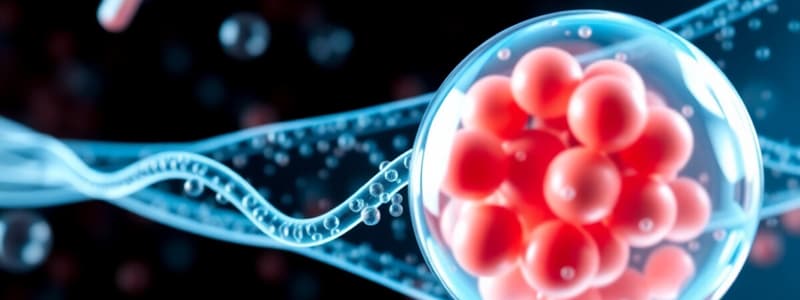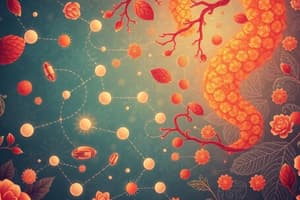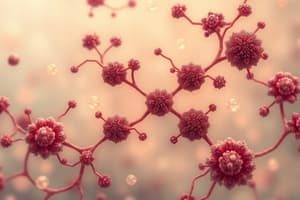Podcast
Questions and Answers
What is the primary reason for the importance of pharmacokinetic (PK) studies in drug development?
What is the primary reason for the importance of pharmacokinetic (PK) studies in drug development?
- To understand the mechanism of action of drugs.
- To determine the optimal dosage for a drug based on its absorption, distribution, metabolism, and excretion. (correct)
- To identify potential side effects and toxicity of drugs.
- To compare the efficacy of different drugs for a particular condition.
What is the primary mechanism of drug absorption for most drugs?
What is the primary mechanism of drug absorption for most drugs?
- Facilitated diffusion.
- Pinocytosis.
- Active transport.
- Passive diffusion. (correct)
What is the role of the 'Rule of Five' in drug development?
What is the role of the 'Rule of Five' in drug development?
- To predict the solubility of a drug in different solvents.
- To determine the optimal route of administration for a drug.
- To assess the likelihood of a drug's absorption and permeation. (correct)
- To estimate the potential toxicity of a drug.
Which of the following is NOT a component of ADME?
Which of the following is NOT a component of ADME?
Which route of drug administration is characterized by immediate and complete absorption?
Which route of drug administration is characterized by immediate and complete absorption?
Which of the following factors can influence the distribution of a drug into different compartments of the body?
Which of the following factors can influence the distribution of a drug into different compartments of the body?
What is the primary function of the blood-brain barrier?
What is the primary function of the blood-brain barrier?
Which of the following is NOT a method for disrupting the blood-brain barrier?
Which of the following is NOT a method for disrupting the blood-brain barrier?
How does plasma protein binding affect drug distribution?
How does plasma protein binding affect drug distribution?
What does the partition coefficient (Po/w) tell us about a drug?
What does the partition coefficient (Po/w) tell us about a drug?
What is the primary goal of drug metabolism?
What is the primary goal of drug metabolism?
What is the relationship between drug metabolism and excretion?
What is the relationship between drug metabolism and excretion?
Which of the following statements best describes the historical use of heroin?
Which of the following statements best describes the historical use of heroin?
Which of the following statements accurately describes the primary role of Phase I metabolic reactions?
Which of the following statements accurately describes the primary role of Phase I metabolic reactions?
What is the main function of conjugation reactions in Phase II metabolism?
What is the main function of conjugation reactions in Phase II metabolism?
Which of the following is NOT a key reason why most drug metabolism occurs in the liver?
Which of the following is NOT a key reason why most drug metabolism occurs in the liver?
What is the primary route of excretion for the majority of drugs and their metabolites?
What is the primary route of excretion for the majority of drugs and their metabolites?
Which of the following is an example of a microsomal enzyme inducer, leading to accelerated drug metabolism?
Which of the following is an example of a microsomal enzyme inducer, leading to accelerated drug metabolism?
Which type of conjugation reaction adds a glucuronic acid molecule to a drug?
Which type of conjugation reaction adds a glucuronic acid molecule to a drug?
Which of the following is NOT a common target for conjugation in Phase II metabolic reactions?
Which of the following is NOT a common target for conjugation in Phase II metabolic reactions?
Which of the following describes the relationship between Phase I and Phase II metabolic reactions?
Which of the following describes the relationship between Phase I and Phase II metabolic reactions?
Which of the following factors does not influence drug distribution?
Which of the following factors does not influence drug distribution?
Which of the following routes of drug administration will exhibit an absolute bioavailability of 1 (or 100%)?
Which of the following routes of drug administration will exhibit an absolute bioavailability of 1 (or 100%)?
Which of the following is not a characteristic of a drug with high lipid solubility?
Which of the following is not a characteristic of a drug with high lipid solubility?
What is the term used to describe the fraction of the administered drug dose that reaches the systemic circulation?
What is the term used to describe the fraction of the administered drug dose that reaches the systemic circulation?
Which of the following describes the primary difference between the therapeutic and toxic effects of a drug?
Which of the following describes the primary difference between the therapeutic and toxic effects of a drug?
Flashcards
Pharmacokinetics (PK)
Pharmacokinetics (PK)
The study of how the body affects a drug through ADME processes.
ADME
ADME
The processes of Absorption, Distribution, Metabolism, and Excretion of drugs.
Absorption
Absorption
The process of a drug moving from administration site to bloodstream.
IV vs Oral Administration
IV vs Oral Administration
Signup and view all the flashcards
Rule of Five
Rule of Five
Signup and view all the flashcards
Non-ionised drug
Non-ionised drug
Signup and view all the flashcards
First Pass Metabolism
First Pass Metabolism
Signup and view all the flashcards
Bioavailability
Bioavailability
Signup and view all the flashcards
Therapeutic Index
Therapeutic Index
Signup and view all the flashcards
Distribution of drugs
Distribution of drugs
Signup and view all the flashcards
Oxidation
Oxidation
Signup and view all the flashcards
Phase II Reactions
Phase II Reactions
Signup and view all the flashcards
Conjugation
Conjugation
Signup and view all the flashcards
Microsomal enzymes
Microsomal enzymes
Signup and view all the flashcards
Glucuronidation
Glucuronidation
Signup and view all the flashcards
Excretion
Excretion
Signup and view all the flashcards
Renal Excretion
Renal Excretion
Signup and view all the flashcards
Detoxification step
Detoxification step
Signup and view all the flashcards
Volume of Distribution (Vd)
Volume of Distribution (Vd)
Signup and view all the flashcards
Blood-Brain Barrier (BBB)
Blood-Brain Barrier (BBB)
Signup and view all the flashcards
Plasma Protein Binding
Plasma Protein Binding
Signup and view all the flashcards
Partition Coefficient (Po/w)
Partition Coefficient (Po/w)
Signup and view all the flashcards
Drug Elimination
Drug Elimination
Signup and view all the flashcards
Drug Metabolism
Drug Metabolism
Signup and view all the flashcards
Heroin Conversion
Heroin Conversion
Signup and view all the flashcards
Study Notes
Pharmacokinetics
- Pharmacokinetics (PK) is the study of how the body handles drugs.
- It describes what the body does to the drug.
- The disposition of a drug includes the processes of ADME (absorption, distribution, metabolism, and excretion) and toxicity.
ADME
- Absorption: The process by which drugs move from the site of administration to the bloodstream.
- Distribution: The movement of the drug from the blood to and from tissues. Factors influencing distribution include partitioning across membranes, binding to tissue/blood components (RBCs, plasma proteins), and physiological volumes.
- Metabolism: The chemical modification of drugs to make them more water-soluble for easier excretion. Enzymes play a crucial role in metabolism.
- Excretion: The irreversible removal of drugs from the body. Common routes include biliary and renal systems, and other routes like lungs, skin, etc.
Drug Discovery and Development
- Discovering and developing a drug takes 10-15 years.
- The likelihood of success is only 10%.
- The cost is $800 million to $1 billion.
- The process involves several stages, including discovery, preclinical and clinical development, and approval.
Why Drugs Fail
- Pharmacokinetics accounts for roughly 30% of drug failures.
- Other reasons for failure include animal toxicity, miscellaneous factors, adverse effects in humans, commercial reasons, and lack of efficacy.
Importance of PK Studies
- Toxic drugs may accumulate in the body. This is harmful to the patient.
- Useful drugs may not have a therapeutic effect if the dose is too small.
- Drugs can be rapidly metabolized, decreasing effectiveness.
Routes of Administration
- Drug administration can be characterized as parenteral (injection, topical, respiratory) or enteral (oral, rectal).
Absorption
- Absorption is the process of a drug moving from the site of administration into the bloodstream.
- Gastrointestinal absorption is the primary route for most drugs.
- Intravenous (IV) drug administration bypasses the gastrointestinal absorption process.
IV vs Oral
- IV drug administration has immediate and complete absorption, which is directly opposite from oral administration (delayed and incomplete absorption)
The Process of Absorption
- Absorption relies on passive diffusion through cell membranes, particularly those of lipid-soluble compounds.
The Rule of Five
- The Rule of five describes guidelines for drug absorption: five or more hydrogen bond donors, a molecular weight greater than 500, a logP greater than 5, or more than 10 hydrogen bond acceptors. These parameters can affect drug absorption poorly.
Absorption & Ionization
- Non-ionized drugs are more likely to be absorbed, as they are more lipid-soluble.
First Pass Metabolism
- Bioavailability is the fraction of the administered dose that reaches the systemic circulation.
- Liver metabolism can reduce bioavailability significantly when drugs are administered orally.
Determination of Bioavailability
- Absolute bioavailability of a drug given intravenously is 100%
- Bioavailability is expressed as the area under the curve(AUC) values of the non-IV route, divided by the AUC values of the IV route.
Toxicity
- The therapeutic index represents the separation between concentrations of a drug that are toxic and therapeutic.
- A narrow therapeutic index increases the risk of overdose and adverse effects. Factors affecting the therapeutic index include dosage, individual differences, and interaction with other drugs.
Distribution
- The movement of drugs from the blood to other tissues.
- Determined by partitioning across membranes, binding to tissue components, binding to blood components (RBCs, plasma proteins), and physiological volumes.
- The body's fluid compartments (intravascular, interstitial, and intracellular) influence drug distribution.
Factors Affecting drug Volume of Distribution (Vd)
- Blood flow rate, capillary structure (in particular, the blood-brain barrier's impermeability to most water-soluble drugs), and physiological volumes greatly affect Vd.
Blood-Brain Barrier
- This barrier limits the penetration of drugs into the brain.
- Composed of tightly packed cells.
- Water-soluble drugs encounter difficulty to pass through.
- Methods to disrupt it or exploit its mechanisms exist but are not commonly used in drug administration.
Plasma Protein Binding
- Many drugs bind to plasma proteins, especially albumin.
- Binding reduces the amount of free drug available for distribution and actions.
- This reduces their pharmacological efficiency.
Physiochemical Properties (Po/w)
- The partition coefficient (Po/w) determines drug preference for certain tissues.
- Drugs with a high Po/w will pass through cell membranes easily.
- Drugs with a low Po/w have a greater likelihood to stay within the body's water compartments.
Elimination
- The irreversible removal of drugs from the body.
- Involves excretion (removal of unchanged drug or metabolites) and drug metabolism.
Drug Metabolism
- The chemical modification of drugs to promote easier excretion.
- Often involves enzymes like the cytochrome P450 system.
- Metabolites are often less toxic than the parent drug and more water-soluble.
Phases of Drug Metabolism
- Phase I reactions convert drugs into more polar metabolites by adding or unmasking functional groups.
- Phase II reactions involve conjugation with endogenous substrates to further increase water solubility and promote excretion. Common conjugation reactions include glucuronidation, sulphation, and acetylation.
Excretion
- The body's removal of unwanted substances, primarily through the renal (kidney) and biliary (liver) systems.
- Lipophilic drugs might require several metabolic steps to become water-soluble and excretory.
ADME Summary
- A comprehensive overview of the drug journey (absorption, distribution, metabolism, and excretion).
- It demonstrates how a drug moves from its administration site to exert its effects and how it's eventually cleared from the body.
Studying That Suits You
Use AI to generate personalized quizzes and flashcards to suit your learning preferences.




